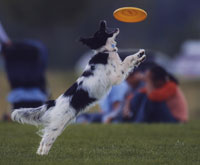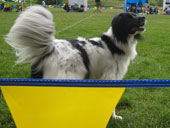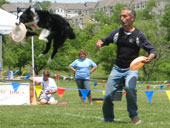… experiments showed that dogs do see color, but in a more limited range than […] humans, who see the rainbow of colors described by “VIBGYOR”: Violet, Indigo, Blue, Green, Yellow, Orange, and Red. Instead, dogs see “VIBYYYR” (Violet, Indigo, Blue, Yellow, Yellow, Yellow, and Red). The colors Green, Yellow, and Orange all look alike to dogs; but look different from Red and different from the various Blues and Purples. Dogs are very good at telling different shades of VIB apart. Finally, Blue-Green looks White to dogs.
– Dana K. Vaughan, Ph.D., Dept. of Biology, University of Wisconsin, Oshkosh
 This is the best information I can find about the color vision of dogs. I really like playing with different colored discs. They make my human eyes happy, but I have a feeling that in most conditions using any color other than white puts Bonnie at a disadvantage. As the article points out, many factors make a greater contribution to a dog’s ability to see an object than color, but if dogs can’t distinguish between green, yellow and orange, using one of those colors on a green grass field removes one potential aid to a dog’s success. Too bad because currently this is my favorite disc (link to yellow hero xtra).
This is the best information I can find about the color vision of dogs. I really like playing with different colored discs. They make my human eyes happy, but I have a feeling that in most conditions using any color other than white puts Bonnie at a disadvantage. As the article points out, many factors make a greater contribution to a dog’s ability to see an object than color, but if dogs can’t distinguish between green, yellow and orange, using one of those colors on a green grass field removes one potential aid to a dog’s success. Too bad because currently this is my favorite disc (link to yellow hero xtra).
 Interestingly, Bonnie won her first Frisbee award with an orange-yellow disc. The sky was overcast and white that morning and I thought the yellow disc made more contrast. Who knows if the color helped or hurt or made any difference at all. If I am ever reincarnated as a dog I will try to send a sign. ; )
Interestingly, Bonnie won her first Frisbee award with an orange-yellow disc. The sky was overcast and white that morning and I thought the yellow disc made more contrast. Who knows if the color helped or hurt or made any difference at all. If I am ever reincarnated as a dog I will try to send a sign. ; )
[Links corrected/added 2010-Jul-01] Another article by Dr. Mark Plonsky. This one has illustrations to explain the differences in human and canine color vision.



 If you live near Colorado Springs or in southern Colorado and always wanted to see Frisbee dogs perform, or even compete with your pup, Sunday is a great opportunity!! Some of the best teams in the country live in Colorado and will be playing on Sunday. There will also be Novice and Recreational divisions. For more information, schedule and map, go to
If you live near Colorado Springs or in southern Colorado and always wanted to see Frisbee dogs perform, or even compete with your pup, Sunday is a great opportunity!! Some of the best teams in the country live in Colorado and will be playing on Sunday. There will also be Novice and Recreational divisions. For more information, schedule and map, go to 